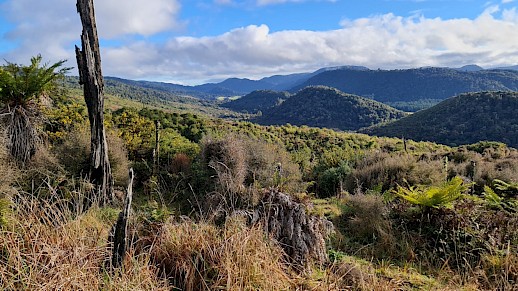 Tautuku Waikawa Lands Trust manages over 1,300 hectares of land on behalf of approximately 2500 owners in nine blocks of Māori General land and two General Land parcels owned by Māori in the Catlins/Chaslands in the Clutha District Council Area.
Tautuku Waikawa Lands Trust manages over 1,300 hectares of land on behalf of approximately 2500 owners in nine blocks of Māori General land and two General Land parcels owned by Māori in the Catlins/Chaslands in the Clutha District Council Area.
The TWLT trust currently has three court-appointed trustees, who were appointed on 3 November 2010 in Ōtepoti Maori Land Court by Craig Tamihana Coxhead, Judge.
- Mr Richard Charles Tainui Manning
- Mr Graham David Nutira
- Mr Leslie Dunn
You can read the profiles of the trustees here.
Objectives of the Trust
The objectives as set in the 1989 Te Kooti Whenua Māori Trust Court Order are:
- Land Management and Use:
To manage, use, and alienate the land to the best advantage of the beneficial owners, ensuring its retention for the present Māori beneficial owners and their successors. - Beneficial Use:
To enhance the habitation or use of the land by beneficial owners and to address any special needs of the owners as a family group or groups. - Representation:
To represent the beneficial owners in all matters related to the land and its use and enjoyment. - Environmental Preservation:
To preserve the native bush cover as far as practical and to enhance Tapu areas, ensuring the past history of the lands is brought to the attention of all beneficial owners and their successors.
Brief history
The Tautuku-Waikawa lands have a rich history that interlaces Māori heritage, land legislation, and environmental stewardship.
TWLT was established on September 14, 1989, by Trust Order in the presence of Judge Norman Francis Smith, Esquire.
The Tautuku-Waikawa lands were a portion of the lands allocated in 1906 when the South Island Landless Natives Act (SILNA) was enacted. SILNA was passed in response to the Crown’s broken promises. The Crown acquired 345,000 acres of land in the South Island, promising the local Iwi that they would retain ample reserves.
After the Treaty of Waitangi was signed in 1840, the Crown acquired large swathes of land all over the country, 345,000 acres of which were in the South Island. The Crown promised the local Iwi that they would retain ample reserves; this was not the case.
In response to this broken promise, the South Island Landless Natives Act (SILNA) was enacted in 1906. The Act aimed to transfer land to South Island Māori to ensure their future economic stability. Approximately 57,000 hectares of land were allocated, primarily in remote areas that were not traditional ancestral domains. These lands were intended to compensate for the taken land and unfulfilled promises.
The Nga Tahu 1997 Settlement excluded SILNA land claims, and discussions on compensation still exist.
In the 2000s, TWLT purchased two parcels of General Freehold land called the Hayes & York Block.
Recently, land development was undertaken on Hayes Block after trustees had removed the land from a lease due to non-payment. The development has included scrub clearing, boundary fencing and forestry development.

